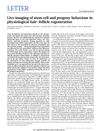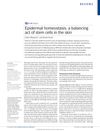Dynamic spatiotemporal coordination of neural stem cell fate decisions through local feedback in the adult vertebrate brain
July 2020
in “
bioRxiv (Cold Spring Harbor Laboratory)
”
TLDR Neural stem cells use local feedback to maintain balance in the adult brain.
The study investigated the mechanisms controlling neural stem cell (NSC) populations in the adult vertebrate brain, focusing on how these cells maintain homeostasis over a lifetime. Researchers used dynamic imaging, pharmacological manipulations, mathematical modeling, and spatial statistics to reveal that NSCs coordinate their division decisions through spatiotemporally resolved local feedback mechanisms. These mechanisms include Notch-mediated inhibition from transient neural progenitors and a dispersion effect from dividing NSCs, with a delay of 9-12 days. Simulations using a stochastic NSC lattice model showed that these interactions are linked by lineage progression and control the spatiotemporal distribution of output neurons. The findings highlighted the role of local and temporally delayed interactions in maintaining NSC population homeostasis with specific spatiotemporal correlations.

